Others - Fotogalerie - Photo gallery
Image database with photographs of ancient art and antiquities
Our image database provides photographs of ancient art and antiquities for press releases as well as for private use. All artefacts sold in our gallery are documented through professional photographs. The resulting image library contains numerous ancient Egyptian, Greek and Roman antiquities as well as ancient coins. The time span from Stone Age, over Bronze Age and Classical Antiquity until Late Antiquity is covered.The photo gallery aims at providing a vast visual archive equipped with filters and search tools. You are most welcome to search the constantly growing number of artefacts in the image library. We are also happy to authorize hyperlinks from your webpage / forum to the objects depicted in our gallery. For this purpose, please send us a short notification prior to placing a hyperlink. For almost every object high definition photographs are available and can be provided e.g. to document your collection or for scientific papers or popular science articles. If you are interested in using pictures for publications, print media or other purposes, please contact us and we will be happy to assist you.
-
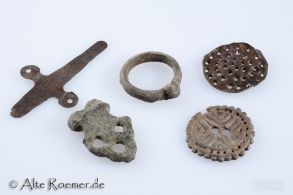 römische Beschläge aus Bronze
römische Beschläge aus BronzeLot aus 5 Kleinbronzen, perfekt erhalten mit schöner Patina. Aus alter deutscher Sammlung.
Price: on request Kleine griechische Olpe
Kleine griechische OlpeMiniaturausführung eines griechischen Kännchens. Möglicherweise Votivkeramik oder Spielzeug. Klassische Epoche, etwa 4. Jh. v.Chr., rot-schwarze Glasur, rote Bemaltung.
Price: on request Roman military whistle
Roman military whistleHistorically interesting example of Roman military equipment. Whistles of this type have been used in the 1st to 2nd cent. AD. Their function is not fully understood, yet.
Price: on request Whistle from plastic bronze
Whistle from plastic bronzeNice small whistle made of a high lead content bronze. Probably produced in the Modern Age.
Price: on request Roman military whistle
Roman military whistleHistorically interesting example of Roman military equipment. Whistles of this type have been used in the 1st to 2nd cent. AD. Their function is not fully understood, yet.
Price: on request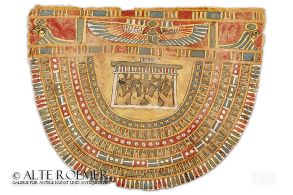 Central part of a mummy cartonnage
Central part of a mummy cartonnagePolychrome painted panel depicting the four sons of Horus and a representation of Kheper-Ra. The collar is resembling the falcon wing of Horus.
Price: on request Egyptian sarcophagus mask
Egyptian sarcophagus maskImpressive wood relief of an idealized face. Polychrome paint. The mask was part of a sarcophagus lid from the New Kingdom of Ancient Egypt.
Price: on request Ptolemaic sarcophagus mask
Ptolemaic sarcophagus maskImpressive wood relief of an idealized face. Remains of paint. The mask was part of a sarcophagus lid from Ancient Egypt during ptolemaic rule.
Price: on request Appliqué of the Horus Son Imsety
Appliqué of the Horus Son ImsetyBeautiful turquoise fayence from the Late Period of Ancient Egypt. From the Toledo Museum of Arts collection, acquired in 1924 from the famous antiquities dealer R. H. Blanchard.
Price: on request Egyptian predynastic cosmetic palette
Egyptian predynastic cosmetic paletteHigh quality palette with two stylized bird heads. Characteristic for the Naqada II period. Circa 3500 to 3200 BC.
Price: on request Roman mirror from Baalbek
Roman mirror from BaalbekThe bronze disc is the base plate of a bronze mirror, that was once attached to a handle and coated with a reflective metal layer. Typical for upper class Roman households during Imperial times.
Price: on request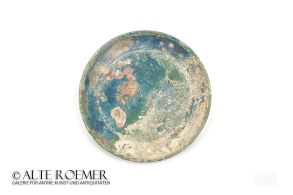 Roman mirror from Baalbek
Roman mirror from BaalbekThe bronze disc is the base plate of a bronze mirror, that was once attached to a handle and coated with a reflective metal layer. Typical for upper class Roman households during Imperial times.
Price: on request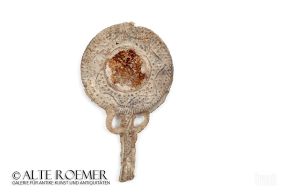 Late Roman votive mirror
Late Roman votive mirrorExceedingly rare in this state of preservation, including remains of the original glass and reflective lead foil.
Price: on request Egyptian headrest amulet
Egyptian headrest amuletInteresting weres amulet type based on larger headrests that served the Egyptians as pillows. From the Boston Museum of Fine Arts collection. Late Period of Ancient Egypt.
Price: on request Jama-Coaque roller stamp
Jama-Coaque roller stampClay roller stamp with rich ornamental relief to apply skin decoration. This tool was used in the early phase of the ecuadorian Jama-Coaque culture.
Price: on request Jama-Coaque roller stamp
Jama-Coaque roller stampClay roller stamp with relief of mythological creatures to be applied as a skin decoration. This tool was used in the early phase of the ecuadorian Jama-Coaque culture and was found in Pedernales.
Price: on request Appliqué of the Horus Son Imsety
Appliqué of the Horus Son ImsetyWonderful bichrome faience from the 30th dynasty or slightly later. Deaccessioned from an old museum lending collection.
Price: on request Side frame of a Roman stool
Side frame of a Roman stoolPiece of a seating furniture with elaborate openwork designs. The fantastic state of preservation is known from other bronze stools found in Pompeii and the area around Mount Vesuvius.
 Egyptian plaque of Bes
Egyptian plaque of BesRare type of depiction of the dwarf god. From the collection of the Newark Museum of Art. Late Period of Ancient Egypt. Including thermoluminescence analysis.
Price: on request Egyptian mummy cartonnage from Thebes
Egyptian mummy cartonnage from ThebesChest and leg piece of a mummy cartonnage from the ptolemaic period. Covered with polychrome paintings giving an interesting insight into ancient Egyptian funerary rituals.
Price: on request Egyptian mummy cartonnage
Egyptian mummy cartonnageCentral piece of a mummy cartonnage from the ptolemaic period. Covered with polychrome paint giving an interesting insight into ancient Egyptian funerary rituals. Probably originating from Akhmim in Upper Egypt.
Price: on request Jama-Coaque roller stamp
Jama-Coaque roller stampClay roller stamp with relief of stylized plants used to apply skin decoration. This tool is from the early phase of the ecuadorian Jama-Coaque culture.
Price: on request Jama-Coaque roller stamp
Jama-Coaque roller stampClay roller stamp with relief of plants to be applied as skin decoration. This tool was used in the early phase of the ecuadorian Jama-Coaque culture.
Price: on request Base plate of a Roman mirror
Base plate of a Roman mirrorThe bronze disc is the base plate of a Roman mirror. A handle and reflective metal coating were once part of the mirror. Typical for upper class Roman households during Imperial times.
Price: on request Ancient ladle with bird head terminal
Ancient ladle with bird head terminalElegant long bronze ladle, from the Greek or Etruscan culture. 5th to 4th century BC.
Price: on request Base plate of a Roman mirror
Base plate of a Roman mirrorPerfectly preserved bronze plate of a Roman mirror. A handle and reflective metal coating were once part of the object. Typical for upper class Roman households during Imperial times.
 Egyptian coffin with snake
Egyptian coffin with snakeThe small bronze votive box is modelled on top with a coiled serpent. The artefact was probably made around 400 BC in Naukratis to be devoted to Atum.
Price: on request Babylonian clay plaque with erotic scene
Babylonian clay plaque with erotic scenePanel with a religious function in the Old Babylonian Empire. The relief shows a man and a woman during the sexual act, with the woman drinking beer through a straw.
Price: on request Ancient ladle with donkey head terminal
Ancient ladle with donkey head terminalElegant long bronze ladle, from the Greek or Etruscan culture. 5th to 4th century BC.
Price: on request Egyptian painted panel with goddess Imentet
Egyptian painted panel with goddess ImentetThe painting was once on the inside of a sarcophagus lid, as a welcome to the underworld. The piece is published in an exhibition catalogue from 1972. From the 25th or 26th dynasty of Ancient Egypt.
Price: on request Egyptian sarcophagus mask with beard
Egyptian sarcophagus mask with beardPainted wooden relief showing a frontal view of an idealized face. A long fake beard is prominently attached. From the Late Period of Ancient Egypt.
Price: on request Roman appliqués of Sol Invictus and Luna
Roman appliqués of Sol Invictus and LunaEnsemble of two nice terra cotta examples of the cult around the Roman sun god and moon goddess in Roman Imperial times.
 Egyptian headrest for a funeral or daily use
Egyptian headrest for a funeral or daily useThe well-preserved wood object is a rare example for this funenary ritual. The high quality piece was made around the Amarna Period in the late 18th dynasty of ancient Egypt.
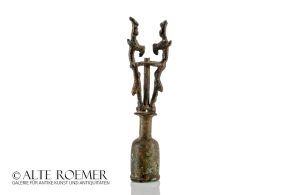 Luristan bronze standard with ibexes
Luristan bronze standard with ibexesBronze standard with stand from Iron Age Northern Iran. Decorated by a pair of ibexes. Possibly a teraphim, a house god, as referred to in the Old Testament.
 Iron Age bronze belt
Iron Age bronze beltWide bronze belt with five wild animals in repoussé. From the biblical land of Ararat, the Urartian Empire around 700 BC.
 Horse bit from Luristan
Horse bit from LuristanDelightful artefact attesting the dawn of horse breeding in Western Iran during the 8th century BC. Two joined triangles form the cheek pieces.

